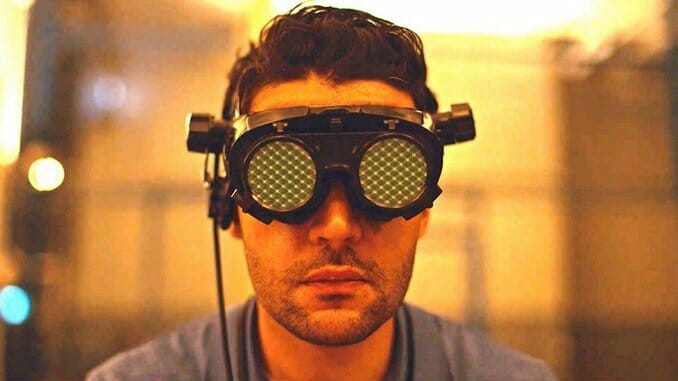Dan Martin on Prosthetics, Props and Puppets in Brandon Cronenberg’s Possessor

About an hour into Brandon “Son of David” Cronenberg’s new film, Possessor, one character takes a vicious beating to the head, face and neck by a man whose mind isn’t his own. Colin Tate (Christopher Abbott) has been hijacked by Tasya Vos (Andrea Riseborough), a corporate assassin who deposits her consciousness into her victims’ brains and destroys them from within rather than without. Each swing of the club is done by Colin’s hand, but the mind driving him is Tasya’s. Mercifully, the moment lasts a few minutes only, but the crew actually shot around five times that amount of footage—best to cover one’s ass when filming remorseless brutality, apparently.
But five times almost feels thin to hear effects and makeup designer Dan Martin tell of the various prosthetics, props and puppets that went into making the sequence happen. “We shot the versions we did with the actor on location,” he says. “We shot all the puppet stuff on a separate day. It got its own mini setup when we were shooting it, and I have the extended versions of those takes. I’ve got the rushes still. If they’d used all of that, then that character would have been beaten for a solid 15 minutes.” He laughs, not at the thought of a 15 minute savage beating, but more at the semi-absurd effort required to convincingly break down the human form on screen. Repeatedly setting up dialogue between characters is one thing. Doing that same task for cranial devastation is another.
Possessor, Cronenberg’s second feature following 2012’s Antiviral, can be divided into three distinct parts: the script, the cast and the effects. The first two pieces are elliptical on purpose. Cronenberg writes with an occlusive hand while both Riseborough and Abbott are enigmas throughout. That leaves the effects, and in horror writ large and Possessor specifically, effects are fundamental. Other genres rely on effects too, of course, but horror films, as Martin sees it—and especially horror films shot on smaller budgets—justify the use of effects better than other filmmaking modes. “Horror has always been seen as an opportunity for investors because it’s got a comparatively high rate of return on its investment,” he explains. “You’re not gonna find an independent biopic that’s being shot for $1.5 million spending a good portion of that budget on old age makeup for a character.” A biopic can’t spare that expense. Nobody goes to see movies like that for effects work in the first place.
But people do pay the price of admission on horror movies partly, possibly even predominantly, for the effects, so the genre and the effects are interwoven: The latter serves the intentions of the former, whether in a slasher flick where creative, gory and agonizing death sequences are the attraction, or in a film like Possessor, where the effects augment the ambiguity of the filmmaking. Film being a visual medium, the line where ambiguity tips into confirmation of what’s unfolding before our eyes becomes perilously thin, and Possessor toes that line from the outset. The question of whether it’s Tasya in control of Colin or Colin in control of himself hangs over each scene once Tasya transfers herself into Colin, and the matter of where their identities start to bleed into each other remains inscrutable to the last. Maintaining that necessary mystery becomes a challenge under these criteria.
-

-

-

-

-

-

-

-

-

-

-

-

-

-

-

-

-

-

-

-

-

-

-

-

-

-

-

-

-

-

-

-

-

-

-

-

-

-

-

-








































